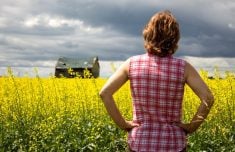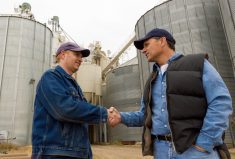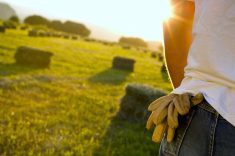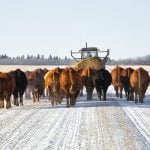Krystyna Delahaye didn’t always see herself as a farmer. Back in 2012, she wasn’t one. Originally from Quebec, Delahaye had simply moved to B.C. to work front of house in a restaurant and she met Jason Stashko, who was working as a cook in another restaurant.
It’s a story similar in its way to the stories that used to lead to successful farms all across Canada, where a shoe-string truck-farming or market-gardening operation got started by recent immigrants looking for a way to make a life in a new world.
Except, Delahaye’s story is today, not 50 or 100 years ago. And if Delahaye and Stashko are immigrants, it’s from the world outside of agriculture, not overseas.
Read Also

The big squeeze: How to be fair to siblings during farm succession
Managing sibling business relationships on family farms.
“We realized we didn’t know where the produce (came) from,” Delahaye recalls she and Stashko saying. “In the restaurant industry we lacked a connection with the farmers, and even understanding how food is grown.” Soon, the two moved in together and started their own vegetable garden.
It wasn’t exactly a success, Delahaye remembers. Everything died — a sign of how incredibly far they were from anything that could be called a farm life.
“We ended up with one tomato at the end of our first gardening season. But it looked like a smiley face,” she says. And with that unreal kind of confidence that only someone who doesn’t know what they’re getting into can have, they took it as an omen and kept working on the garden.
Then came a moment when neither of them had employment, and they took another leap, starting a farm apprenticeship with Chris Bodnar at Close to Home Organics in Abbotsford.
“It was the best apprenticeship that we could have gotten from a farmer,” says Delahaye. “Chris thinks the world doesn’t need any more grumpy farmers. We loved our season with him and learned a lot — so much so that Jason was ready for us to start a farm the year after our apprenticeship.”
Delahaye and Stashko started Seed of Life Farm in 2017 on a three-acre rented property in Burnaby that belonged to a church. They kept things small, with direct sales to friends and family and a presence at one farmers market.
The land was weedy and there were issues with the lease agreement. Delahaye and Stashko were also learning how to farm and how to run a business simultaneously — a much steeper learning curve than they’d expected.
Despite the challenges, Delahaye says it was a “good beginning.”
“We started the farm with $2,000 dollars combined,” says Delahaye. “The rent was very low — we were paying $350 an acre a year. We started with very little, but the farm had been kind of abandoned and they left a greenhouse and some materials. We made shift with what we had.”
The pair farmed there for two years, she says, and then moved to a second location. That next spot wasn’t a whole lot more promising: the soil was thick with rock and clay. But then, in 2021, they found a third farm location in north Surrey through the B.C. Land Matching Program delivered by Young Agrarians.
This land has better long-term potential, says Delahaye: it’s “heritage land” that’s been farmed for 100 years by their landlord’s parents and family. It’s been used for cattle, as a strawberry farm and more recently as a highly productive market garden. Delahaye and Stashko live there with their daughter Maya and grow vegetables, culinary herbs, and edible and cut flowers.
“Out here, on this land, there’s more of a feeling of permanence, so we feel like we can invest more in our business (and) ultimately feed more people,” Delahaye says.
Land matching
Young Agrarians is a non-profit charitable organization that operates what it calls “a farmer to farmer educational resource network for new and young ecological, organic and regenerative farmers in Canada.”
The organization offers events, training, land access support, mentorships and apprenticeships — mainly in Western Canada. The organization has been growing over the past decade, and now has 20 staff. Its network, partly spurred by highly active social media and educational resources online, stretches coast-to-coast.
There’s a general perception, says Dana Penrice, Prairies program manager for Young Agrarians, that farming isn’t a viable career option if you don’t have a family connection to land or access to startup capital.
“We’re active in presenting farming as an exciting, fun, viable option for people to be part of,” Penrice says. “We try to focus on branding that makes farming look welcoming to people, and for people to be able to see themselves in it. We provide stories and examples of people actually doing it.”
YA provides more than stories, though. In B.C., it also links new farmers to land.
Darcy Smith is the land matching program manager for YA in B.C. She says the organization started its land access work in the province in 2013 by publishing a land access guide that covered purchasing, leasing and land trust options, and running land linking workshops.
“After those events, people were saying, ‘I met a landholder, what do I do next? How do you turn that into a relationship that works?’ We hear about a lot of handshake agreements that go really wrong. It’s time-consuming to move a farm business. We were looking for ways to provide additional support,” says Smith.
YA’s executive director Sara Dent connected with the Quebec-based land matching organization, L’ARTERRE, which helped YA set up its pilot program in B.C.’s Fraser Valley in 2016. These days, the B.C. Land Matching Program has six land matchers who are each responsible for overseeing land matches in a particular region of B.C.
“Land matchers work one-on-one with farmers seeking land to start or grow their farm business, connect them to resources (and) help them develop a business plan. We work with landholders to help them figure out what their vision is and connect them to resources,” says Smith. “If there is a spark — because it is a match making service — the land matcher facilitates conversations to support the negotiation. The land matcher is there to ensure the questions get asked to the level of detail that will help people on the ground, and that gets put into templates, and we have lawyers review the final documents.”
Since 2016, YA has talked to 5,800 people, says Smith — some 2,100 landholders and about 3,600 land seekers.
“We’ve had more than 1,300 people register for the program, 580 of those landholders. We’ve made 245 matches on 9,694 acres. We’re supporting all production types and scales, from half-acre market gardens to thousands of acres of grazing land,” Smith says.
The organization has worked with a huge variety of farms and farmers who have found land in non-traditional ways. Some have accessed family land through distant relations, or farm on co-operatives where the land is held by an entity or individual; but many, says Penrice, are leasing. “Farming is so much of an equity game when it comes to land. For new generation farmers we are seeing much more land leasing, and farmers are building equity in their business in different ways,” she says.
Smith says there’s so much competition from development and other competing land uses for the best agricultural land in B.C. that land values have skyrocketed. “In B.C., the market value of the land has become uncoupled from the production value of the land, but lease rates are still tied to production values, so you can afford to lease land for farming in a way you could not afford to buy that land for agriculture,” she says.
“On the south coast, the average cost of land per acre is $134,000 (according to Farm Credit Canada’s 2021 Farmland Values report). That’s hugely expensive. We see a lot of land in five-acre parcels with a house on it, and that land isn’t as attractive to larger farms for consolidation, but it is attractive to people who want a rural lifestyle and would love to lease it out,” says Smith.
Penrice knows a farmer in Alberta who operates a direct-marketed beef farm in Red Deer. His business model would never work if he had a mortgage, she says. A 2022 report from the Parkland Institute found that land prices in Alberta have risen far beyond the land’s actual agri-economic value.
Costs are rising for renters, too, and renting can leave farmers in a precarious position.
But this is where YA fills a gap: its programming minimizes the odds of mismatch. And Penrice says there’s an urgent need for new farmers in Canada. Lately, she gets a lot of phone calls from older farmers who have land but no successors.
“We talk a lot in the sector about sustainability, and we often equate that with environmental sustainability and economic sustainability, but one of the biggest risks to Canada’s agricultural sustainability is that we really need people on the land,” she says.
“The demographics are against us and we need to be engaging a new generation of farmers and attracting people to our sector. In agriculture right now everyone is talking about the looming labour crises, and I’ve looked at the labour stats and coming out of Covid, it’s worse. We need well-thought-out strategies for addressing this issue. YA has been working on this for the last 11 years, but we can’t hold it all. We need a bigger strategy at play here and more people helping to do this good work.”
Apprenticeships
Several years ago, Penrice was farming in Alberta when she attended her first YA event in B.C., a two-day networking retreat for young farmers.
She remembers sitting in a big introduction circle, where everyone was supposed to stand up in turn and say why they’d come to the event.
“Someone stood up and said she was going to get a tractor on Friday and she didn’t know how to run it, and someone else said they’d come over and help,” says Penrice. “It was one of those experiences in life where you walk into a room and say, ‘These are my people!’”
When Penrice went back to Alberta and talked to a few friends who’d also attended the B.C. event, it became clear that something similar was needed in the Prairies. She began working for YA in 2015, developing programming and fundraising in Alberta. “Somebody drove like six hours to get to our first mixer. You could tell people were yearning for that network and experience,” she says.
Four years ago Penrice moved to her partner’s family farm in Manitoba, and these days she heads up apprenticeship programming in the Prairies. Farming in the Prairies can be isolating, she says, and opportunities for new farmers for networking and learning are few and far between. Historically, if new farmers wanted to do an apprenticeship, they’d have to travel to B.C. or Ontario.
YA is attempting to fill some of these gaps. At the most basic level, the organization offers farm tours and networking events to help people “dip their toes in” and make connections with people in the industry, says Penrice. If new farmers want to progress to the next level, they can apply for an apprenticeship.
Young Agrarians apprenticeships are paid training positions on farms that typically run between eight and 12 months. The program is designed to be immersive, to put apprentices “into the heart of running a farm business, day in and day out.”
“The way the apprenticeships work is that YA handles the administration (and)promotions to attract people to farms, we create a profile for each farm on our website, receive the applications and get them to the farmers. The farmers pick who they’ll work with,” says Penrice.
Stipend packages vary, but the positions are compensated and farms are required to hold Workers Compensation and insurance. It can be challenging for mentor farmers to pay mentees, but YA helps them apply for wage subsidy grants. YA also helps them set up payroll programs and even offers resources on workplace communication and conflict. There’s a review process and exit interview at the end.
It was important to YA to set up the apprenticeship program as a paid opportunity for new farmers, explains Penrice. “We don’t want to have any grey lines. There have been some challenges with apprenticeship in Canada, where (it’s a question whether) this is employment or a volunteer (position). We want to be super clear about that. The paid apprenticeship makes it more attractive to young people to get into the sector.”
In Manitoba, there are about 10 farms enrolled in the program. Last year, YA received over 100 applications for just 30 Prairie positions. Interest in the program is growing, and Penrice says it’s not just mentees who see the benefit.
“For some of the mentors it’s so nice to have other people on the farm alongside them. A lot of farmers are motivated by supporting the next generation, and passing those skills along,” she says. “They do get some kind of value of having an employee there in terms of labour, but (that’s not) the main motivator.”
Once new farmers have finished an apprenticeship, YA offers an online “business bootcamp” that can help participants develop a business plan.
And there’s business mentorship programming that pairs new and seasoned farmers; this year, it’s opening to Prairie farmers for the first time.
“We need farmers”
Penrice says she was attending a Manitoba Beef Producers meeting in late 2022 when someone asked the question, “How do we get more members?”
“You need more beef producers to get more members,” says Penrice.
There are intergenerational farmers in YA’s network. When she spoke to a class of agriculture students at the University of Manitoba last year, she made a point of linking environmental sustainability with succession.
“One of the big challenges we have as a sector is (figuring) out how to transition our farm practices toward sustainability. We need to change our farming practices, there’s an economic imperative, but we’re doing that at the same time as succession, and that’s a big ball of wax,” she told them.
“We often treat succession as a workshop, but how does the sector provide support to make it happen?” she says. “It’s not just about getting a young farmer on the land, but the wrap-around services we can provide through programming and social networks in order to make that opportunity viable for that person. We need to see these businesses thriving.”
Smith says that to get more farmers on the land, outreach that bridges the urban-rural divide is critical. “We really want to inspire people and help them find their pathway into food and farming, whatever that looks like — whether they’re curious and want to learn more, or are already in farming and are looking for resources.
“We often talk about how to get 10,000 people farming. We need to get a million people engaged in agriculture, through events and social media,” Smith says.
Now in their seventh year of farming, Krystyna Delahaye and Jason Stashko have found some of their own assumptions about farmers and farm life are getting challenged.
Delahaye says some people tell her farmers should be competitive, but she thinks there’s enough room for everyone. “Most farmers are very into sharing,” she says. “There are so few farmers, and we all care to keep the trade alive and to feed more people good food. I think farmers want to be there for each other.”
Her advice for the farm-curious? Reach out to an organization like YA and talk to them about your project, she says. “Go onto farms, and live one, two, three, four seasons. Go put your hands in the dirt and try it. When we grow gardens, it’s very romantic and beautiful, but once we farm it’s a whole new dimension. Start a garden, volunteer, or go and work for a farmer for one season or more to see what it is before entering the world of farming. It’s not just one learning experience that will make you a farmer.” It’s a lot to take in, but then there’s that one final thought she leaves them with. “It’s worth it.”
















